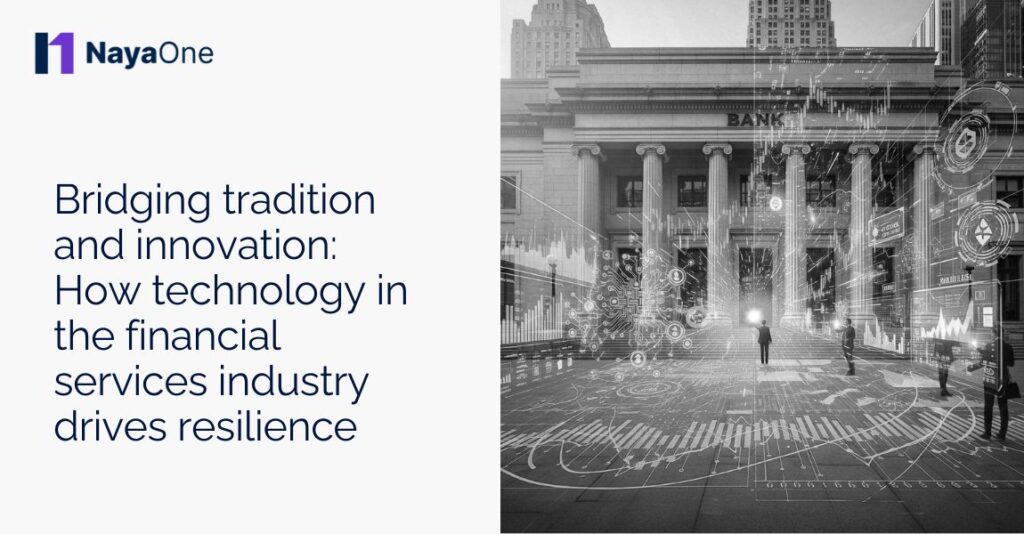The financial services industry has always been a world where trust, tradition, and stability reign supreme. After all, people want to know their money is safe and their investments are secure. But with technology advancing at a rapid pace, this industry faces an interesting challenge: how to hold on to the traditions that build trust while embracing the innovation that fuels progress. That’s where technology in the financial services industry plays a starring role, acting like a bridge between the old and the new, helping organisations become more resilient and ready for whatever comes next.
So, how exactly is this balance achieved? Let’s dive into some key questions that unpack how tradition and innovation work together in this ever-evolving industry.
Why is maintaining tradition still important in the financial services industry?
When you think about the financial services industry, words like ‘trust’ and ‘reliability’ probably come to mind. That’s no accident. For decades, customers and businesses alike have leaned on traditional banking and finance practices because they provide a sense of security. According to the 2024 Edelman Smithfield Trust Barometer, 62% of respondents trust financial services companies to “do the right thing”, marking the first time the sector has reached the “trusted” category globally.
Tradition here means more than just old habits. It is the foundation of strict regulatory compliance, well‑established procedures, and transparent record‑keeping. These are the things that protect customers’ money, guard against fraud, and ensure everything runs smoothly.
The reality is that many customers still expect their financial institutions to act conservatively. They want reassurance that their transactions are safe and that their financial advice comes from experienced, knowledgeable people. This is why financial institutions cannot simply throw tradition out the window when adopting new technologies. Instead, they need to respect and maintain these core values while exploring new ways to improve.
How is technology transforming legacy systems without losing core values?
It might sound like an impossible feat: how do you bring a legacy system, designed decades ago, into the modern age without breaking everything? The answer lies in smart, careful upgrades that embrace technology in the financial services industry without sacrificing what matters most.
One approach is cloud adoption. Moving data and applications to the cloud offers incredible flexibility and scalability, meaning firms can adapt to customer needs faster. But cloud providers also ensure top-notch security measures, helping to keep sensitive financial information protected.
APIs, or application programming interfaces, are another key piece of the puzzle. They allow legacy systems to ‘talk’ to newer apps and services, creating a connected ecosystem without completely ripping out existing infrastructure. This way, firms can introduce digital platforms and new customer experiences while still maintaining their trusted backend systems.
By carefully integrating these technologies, financial institutions uphold the security, compliance, and reliability their customers expect, all while opening the door to innovation and greater efficiency.
What role does innovation play in enhancing resilience amid market uncertainties?
Innovation is more than just a buzzword; it’s a powerful tool for resilience. The financial services industry faces all kinds of uncertainties, from fluctuating markets to unexpected global events. Technology in the financial services industry gives firms the edge they need to navigate these challenges.
Artificial intelligence and machine learning allow companies to analyse vast amounts of data quickly, spotting risks or opportunities that might have gone unnoticed before. For example, AI can flag suspicious transactions faster than any human could, helping to prevent fraud in real time.
Automation also plays a huge role. By automating routine tasks like claims processing or customer onboarding, firms reduce human error and free up employees to focus on higher-value work. This improves both speed and accuracy, which are crucial when market conditions shift suddenly.
Real-time data analytics provide ongoing insights that allow businesses to adjust their strategies on the fly. When combined, these innovations create a financial services environment that is flexible, agile, and able to bounce back from disruptions faster than ever.
How can financial institutions balance innovation with regulatory demands?
It’s no secret that regulation is a major part of the financial services industry. While it might feel like a hurdle, regulation also protects customers and ensures the industry operates fairly. The question is: how can firms innovate without running afoul of these important rules?
Enter ‘regtech’, regulatory technology designed specifically to help financial institutions comply with complex regulations efficiently and accurately. Regtech tools automate compliance checks, monitor transactions for suspicious activity, and even generate reports for regulators automatically. This means firms can keep up with evolving laws without slowing down innovation.
Moreover, collaboration is key. Many financial firms are working closely with regulators to develop ‘sandbox’ environments where new technologies can be tested safely before full-scale deployment. This approach ensures innovation happens within a framework that protects consumers and maintains industry integrity.
Ultimately, technology in the financial services industry is helping institutions to not only meet regulatory demands but also to do so in ways that enhance customer trust and operational resilience.
How does blending tradition with innovation secure the future of financial services?
Striking the right balance between tradition and innovation is no small task for the financial services industry. But it is essential. By respecting time-tested practices while embracing the best financial technology has to offer, financial institutions can build resilience that helps them weather uncertainty and emerge stronger.
Technology in the financial services industry isn’t about replacing the old with the new; it’s about bridging the two to create a future-ready, trustworthy, and agile financial ecosystem. This blend ensures that customers can continue to rely on the institutions they trust, while also enjoying modern, efficient services that keep pace with changing expectations.
As the industry continues to evolve, the secret to success lies in keeping one foot firmly planted in tradition while the other steps boldly into innovation.






